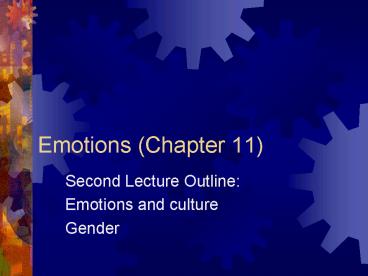Emotions (Chapter 11) - PowerPoint PPT Presentation
Title: Emotions (Chapter 11)
1
Emotions (Chapter 11)
- Second Lecture Outline
- Emotions and culture
- Gender
2
Two Factor Theory of Emotion
- Attributions are cognitive events that contribute
to emotion - E.g., Splash through puddle in car Was it
intentional? If so, anger is greater - Expectations are important as well
Overachieving results in positive emotion, bronze
vs. silver medal winners
EMOTION
Physiological arousal
Cognitive Interpretation
3
Field Experiment
- Go on a blind date
- Before going, eat three chocolate bars
- They are full of caffeine and sugar Results in
a highly alert, physically, and emotionally
aroused state - You may also feel dizzy, ill
- How will you interpret this state?
- Is it attraction to the person you are with?
- Do they make you sick and queasy?
- Is it illness or anger?
- You make cognitive attributions about
physiological states such as these
4
Guilt and Shame
- John goes home to see his parents for the break,
but comes back to Wolfville on Friday to have fun
with friends - Feels bad because parents were disappointed
Views behavior as bad - John does not goes out with his friends because
he feels so bad about himself - His parents have made him feel ashamed of his
behavior Views self as bad - John resents parents for making him feel bad, for
putting him in such a bind - You need a sense of self to feel guilt and shame
as they are interpersonal emotions
5
What is the adaptive function of fear? How is it
displayed?
6
Primary Emotions
- Primary emotions are common to all cultures
- Fear, anger, sadness, joy, surprise, disgust
- Evidence
- Hard-wired, related to survival
- Universal facial expressions
- Common to all languages
- Common elicitors across culture, e.g., burning
building threat elicits fear, pie in face is
funny, bad smells such as ammonia elicits disgust
7
Secondary emotions are influenced by culture
- Guilt and shame
- Culture gives us language for emotions
- There are norms in how emotionally expressive
people are within a culture - Display rules Non-verbal signals of emotion
- E.g. What does it mean to extend first and last
fingers of hand and wave in the air? - Body language, using hands to talk, what emotions
do they indicate?
8
Emotion and gender
- Men react more to provocation or interruption,
physiological evidence supports this - Men and women may differ in their attributions of
emotions or what they think is important - Power interruption during dinner vs. Superbowl
- Women can read emotional signals better
- Same sex expressions easier to read
- Familiar people easier to read than strangers
- How strong are the signals
- Less powerful person becomes better at reading
cues to fit in with more powerful person
9
More on Gender
- Traditional gender roles express less emotion
- Families vary in the degree of emotional
expression, both positive and negative - Situational dependence, e.g., anger expression
towards inferior but not superior individuals - Culture directs gender role behavior as well
10
How do you assess emotional experience?
- Self Report/ Subjective
- Behavioral observations (face, actions)
- Physiological measurement arousal, hormones,
polygraph































